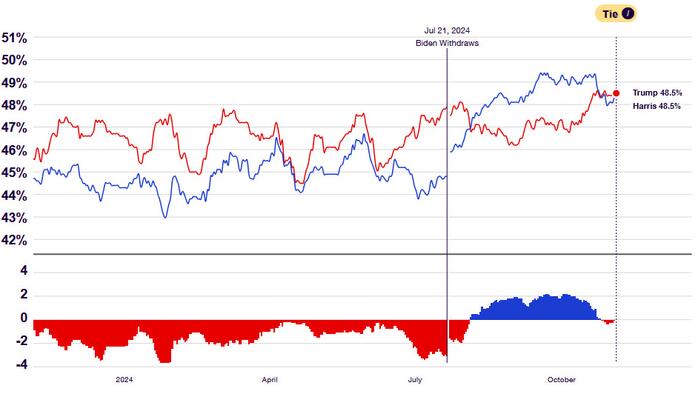The current political atmosphere in the United States is characterized by an unprecedented level of competitiveness in the presidential election race between former President Donald Trump and Vice President Kamala Harris, with polling averages from RealClearPolitics showing both candidates tied at 48.5%. This statistical deadlock reflects a broader trend observed since mid-August, where the candidates have remained within two percentage points of each other. Such a close contest has set the stage for what could be recorded as the tightest election in U.S. history in terms of the popular vote. Analysis of historical elections by DB’s Henry Allen reveals that in the period since the Civil War, several elections have had narrow margins, underscoring the significance of the current political climate.
Throughout U.S. electoral history, there have been notable occasions where the winning candidate did not secure the popular vote. Instances from years like 1888 and 2000 illustrate the complex nature of U.S. voting, where electoral mechanics can sometimes lead to results that appear counterintuitive. The six elections with margins of less than one percentage point, like the 1884 and the infamous 2000 presidential elections, highlight the rare but impactful moments in electoral history. Henry Allen’s examination also notes the market’s responses to these elections, adding a layer of economic analysis to the political outcomes, reflecting how closely tied electoral results are to wider societal dynamics.
The anticipation surrounding the current election outcome is further complicated by concerns over the integrity of the voting process. The 2020 census, which has garnered criticism and is acknowledged by the Census Bureau as inaccurate, has fueled suspicions regarding the allocation of electoral college votes, particularly favoring blue states. A scenario presented by conservative commentator Ben Shapiro suggests that had the census been conducted correctly, Trump could potentially have won without needing support from traditionally Democratic states. This assertion hints at the potential for significant legal battles following the election, should outcomes not align with expectations.
As Election Day approaches, expectations run high for a comprehensive guide detailing key elements that will determine this critical electoral event. An overview focusing on swing states, bellwether counties, and the timeline for vote reporting will be crucial for understanding how the election unfolds. Recognizing which areas are pivotal to the final outcome and tracking their vote counts will help clarify the electoral landscape. This preparation reflects an acknowledgment of both the stakes involved and the strategic considerations that come into play during tightly contested races.
The anticipation also includes procedural considerations, particularly regarding the challenges to voting results in swing states and any changes made to election rules at the federal level since the previous cycle. The rules concerning recounts and challenges will be particularly relevant in this election, as they could prolong the decision-making process. While some states are expected to declare their results relatively quickly, others, particularly Pennsylvania and Georgia, might experience delays—potentially extending days or weeks due to recounts or disputes. This scenario emphasizes the uncertainty trailing closely contested elections, where every vote counts and the implications of the final tally resonate widely.
In preparing for what could potentially be a protracted and contentious post-election phase, the political and legal ramifications will need to be monitored closely. With a tight race historically linked to upheaval or discord, the impending avalanche of lawsuits and challenges may mirror previous electoral disputes. As the nation braces itself for a potential drawn-out result, the atmosphere remains charged with significance. Whether the eventual outcome mirrors current predictions or diverges based on unforeseen developments, one thing is clear: the stakes are higher than ever, with numerous citizens keenly watching the unfolding drama of democracy in action.

